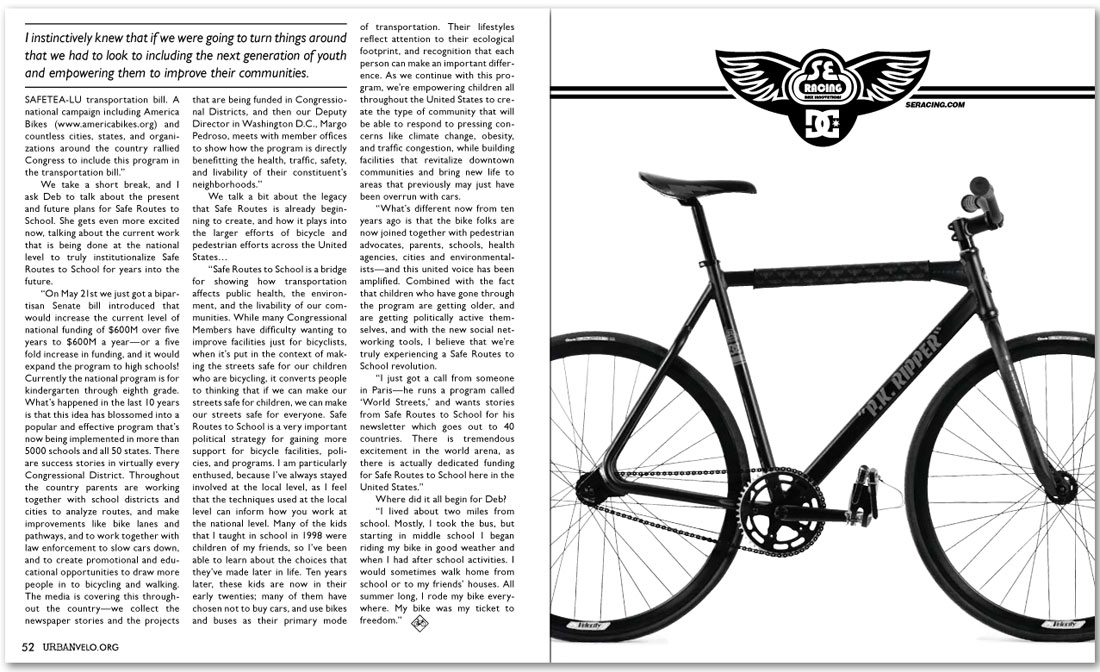

|
||||
| SAFETEA-LU transportation bill. A national campaign including America Bikes (www.americabikes.org) and countless cities, states, and organizations around the country rallied Congress to include this program in the transportation bill.” We take a short break, and I ask Deb to talk about the present and future plans for Safe Routes to School. She gets even more excited now, talking about the current work that is being done at the national level to truly institutionalize Safe Routes to School for years into the future. “On May 21st we just got a bipartisan Senate bill introduced that would increase the current level of national funding of $600M over five years to $600M a year—or a five fold increase in funding, and it would expand the program to high schools! Currently the national program is for kindergarten through eighth grade. What’s happened in the last 10 years is that this idea has blossomed into a popular and effective program that’s now being implemented in more than 5000 schools and all 50 states. There are success stories in virtually every Congressional District. Throughout the country parents are working together with school districts and cities to analyze routes, and make improvements like bike lanes and pathways, and to work together with law enforcement to slow cars down, and to create promotional and educational opportunities to draw more people in to bicycling and walking. The media is covering this throughout the country—we collect the newspaper stories and the projects that are being funded in Congressional Districts, and then our Deputy Director in Washington D.C., Margo Pedroso, meets with member offices to show how the program is directly benefitting the health, traffic, safety, and livability of their constituent’s neighborhoods.” We talk a bit about the legacy that Safe Routes is already beginning to create, and how it plays into the larger efforts of bicycle and pedestrian efforts across the United States… “Safe Routes to School is a bridge for showing how transportation affects public health, the environment, and the livability of our communities. While many Congressional Members have difficulty wanting to improve facilities just for bicyclists, when it’s put in the context of making the streets safe for our children who are bicycling, it converts people to thinking that if we can make our streets safe for children, we can make our streets safe for everyone. Safe Routes to School is a very important political strategy for gaining more support for bicycle facilities, policies, and programs. I am particularly enthused, because I’ve always stayed involved at the local level, as I feel that the techniques used at the local level can inform how you work at the national level. Many of the kids that I taught in school in 1998 were children of my friends, so I’ve been able to learn about the choices that they’ve made later in life. Ten years later, these kids are now in their early twenties; many of them have chosen not to buy cars, and use bikes and buses as their primary mode of transportation. Their lifestyles reflect attention to their ecological footprint, and recognition that each person can make an important difference. As we continue with this program, we’re empowering children all throughout the United States to create the type of community that will be able to respond to pressing concerns like climate change, obesity, and traffic congestion, while building facilities that revitalize downtown communities and bring new life to areas that previously may just have been overrun with cars. “What’s different now from ten years ago is that the bike folks are now joined together with pedestrian advocates, parents, schools, health agencies, cities and environmentalists—and this united voice has been amplified. Combined with the fact that children who have gone through the program are getting older, and are getting politically active themselves, and with the new social networking tools, I believe that we’re truly experiencing a Safe Routes to School revolution. “I just got a call from someone in Paris—he runs a program called ‘World Streets,’ and wants stories from Safe Routes to School for his newsletter which goes out to 40 countries. There is tremendous excitement in the world arena, as there is actually dedicated funding for Safe Routes to School here in the United States.” Where did it all begin for Deb? “I lived about two miles from school. Mostly, I took the bus, but starting in middle school I began riding my bike in good weather and when I had after school activities. I would sometimes walk home from school or to my friends’ houses. All summer long, I rode my bike everywhere. My bike was my ticket to freedom.” |
|
|